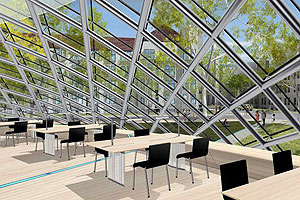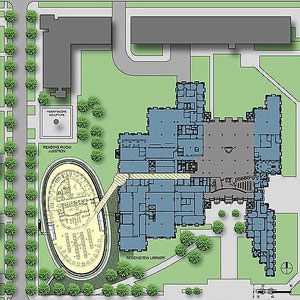Mansuetos’ $25 million gift supports innovative library
By Julia Morsemorse@uchicago.edu
News Office
 Architect Helmut Jahn designed the new elliptical glass-domed Joe and Rika Mansueto Library, which will be built adjacent to the Joseph Regenstein Library. The architecture of the new library positions the automated storage and retrieval system below ground, minimizing any undesirable vertical impact an above-ground structure might have, while adding to the beauty and architectural significance of the University campus. The Mansuetos’ $25 million gift will provide support to build the new library, which will allow the University to continue to keep its printed collections on campus rather than housing them off-site. | |
 Above is an architect’s rendering of the grand reading room, where library patrons may consult the materials they have requested. Patrons will be able to search for and request items online. Within five minutes, the robotic crane of the automated storage and retrieval system will locate and deliver the materials to the ground floor, where a librarian will dispense them to the patron. Special Collections materials will be delivered directly to the Special Collections Research Center reading room for use by patrons. | |
 | |
 Alumni Rika and Joe Mansueto have provided a $25 million gift to the University for a new library that will store up to 3.5 million printed volumes at the on-campus facility. | |
 Helmut Jahn (at left) consults with Judith Nadler, Director of the Library, during a planning visit to the Joseph Regenstein Library. |
A $25 million gift from alumni Joe and Rika Mansueto will support construction of a new library at the University.
Renowned Chicago-based architect Helmut Jahn designed the Joe and Rika Mansueto Library, which will be a partially underground facility topped with a glass dome and will have the capacity to house 3.5 million volumes of print material—making the University’s library the country’s sole top academic research library to keep its entire collection on campus.
“This library combines three of our passions: great design, the free exchange of information and the University of Chicago. That’s why Rika and I couldn’t be more thrilled to be a part of this project,” said Joe Mansueto, Chairman and CEO of Morningstar, Inc., a premier investment research firm.
President Zimmer said, “These scholarly materials are at the very core of intellectual life and intellectual activity at Chicago. This effort to keep the materials at the University and in the heart of our campus is a reaffirmation of their immense value.”
While other universities, including Harvard, Yale, Columbia and Brown, have moved books off campus, the Joe and Rika Mansueto Library will ensure that books remain at the center of the University campus.
“This collection of immense scholarly value will be housed, preserved and delivered to our community in a state-of-the-art environment,” said Judith Nadler, Director of the Library.
The Joe and Rika Mansueto Library will be located beside the Joseph Regenstein Library at South Ellis Avenue and East 57th Street. Construction on the project will begin this summer, and the new library will open in the fall of 2010.
“Physical location and academic mission are inseparable,” Nadler said. “Interdisciplinary research—a distinguishing feature of the University—is best supported by integrated collections on-site and at scholars’ fingertips. Dispersed and off-site solutions would create barriers to interdisciplinary initiatives and programs.”
In 2003, a faculty committee was organized to examine and review options for increasing shelving space for books and other materials at Regenstein Library, which met its capacity in 2007.
After research and discussion with colleagues, students and library staff, the committee expressed in its final report that following the trend of peer institutions and moving materials off-site would not be ideal. The committee expressed that the ultimate solution would be constructing a facility on campus to house these valuable print materials.
“In true Chicago fashion, we are doing this only after thinking long and hard about it,” said Andrew Abbott, the Gustavus F. & Ann M. Swift Distinguished Service Professor in Sociology and the College. “We have both a practical and theoretical rationale for what we are doing. It’s not based on knee-jerk traditionalism, but on serious scientific study of the library as well as on explicit theorizing about the library’s potential use.”
Abbott said cutting-edge research depends heavily on having immediate access to the widest variety of materials, a point that library circulation data reinforce.
“The Joe and Rika Mansueto Library will make Chicago unique among American university libraries in its commitment to cutting-edge scholarship in the library research fields,” Abbott said. “In practice, we will become a place scholars come to from other universities.”
Marriage between print and technology
Abbott emphasized the important relationship between print and electronic resources.
“Most of our evidence suggests that the heaviest electronic users of library materials are also the heaviest physical users. The two are complementary, not antagonistic,” he said. Nadler agreed, noting that the use of online resources fuels the use and discovery of physical resources.
In June 2007, the library announced it would be one of 12 university research libraries partnering with the Google Book Search project to digitize select collections, providing broader and more in-depth access to historically significant print resources. Through the agreement, Google will digitally scan and make searchable both public domain and copyright materials in a manner consistent with copyright law.
Nadler added, “Scholarship will thrive in an environment where print and electronic materials coexist. Our investment in the marriage between print and electronic is an investment in scholarship, now and in the future.”
Related Stories:
Design utilizes progressive approach to print storage
Recollections of Regenstein inspired Mansuetos’ library gift
![[Chronicle]](/images/sidebar_header_oct06.gif)